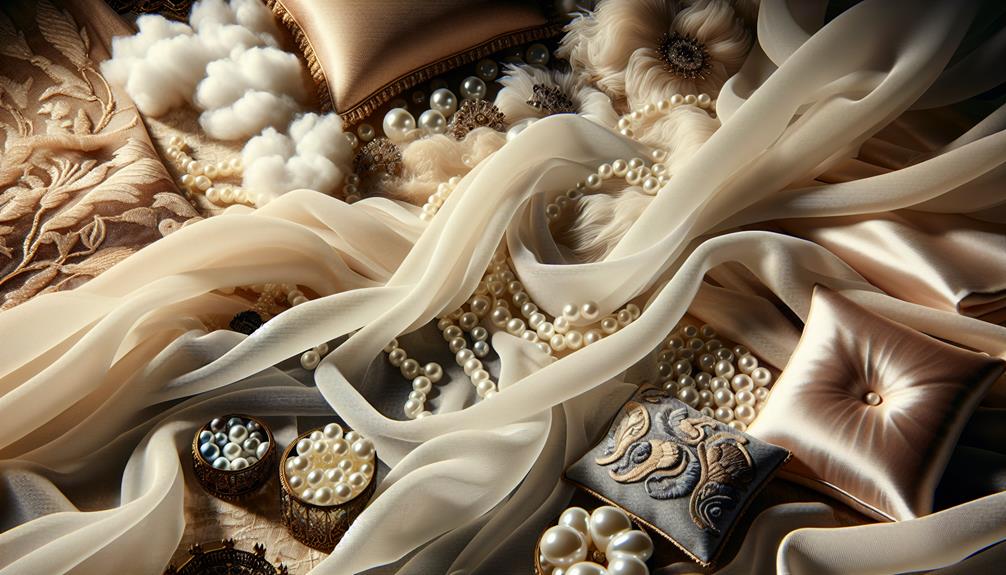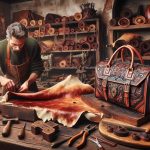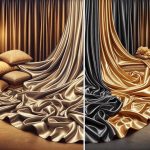Yeah, I've noticed that pure chiffon tends to be on the pricier side. It's all because it's made from silk, which is expensive right from the get-go. The process to make chiffon is also pretty intensive, requiring skilled labor every step of the way, from twisting the fibers, to weaving, to the final touches that give it that fancy feel. Add in some import taxes and you're looking at a fabric that's not cheap. But it sure adds an elegant touch wherever it's used, like in evening gowns and scarves. Stick around, and I'll share some insights on why investing in chiffon might just be worth it.
Table of Contents
Key Takeaways
- Pure chiffon is costly due to its labor-intensive production and the high cost of silk.
- The delicate nature of chiffon requires skilled craftsmanship, increasing its price.
- Import taxes and global market dynamics can further elevate chiffon's cost.
- Chiffon's elegance and luxurious feel justify its higher price in high-end fashion.
- Maintenance costs, including dry cleaning and special care, add to its overall expense.
Understanding Pure Chiffon
Before we dive into why pure chiffon might be pricey, let's clarify what it actually is. Pure chiffon is a lightweight, sheer fabric known for its airy quality and slight stretch. It's made from silk, which gives it that luxurious feel and elegant drape. When you hold a piece of pure chiffon, you'll notice its slightly rough texture, a result of the twists in the yarns, which are tightly spun for strength.
Now, why should you care about these details? Well, if you're looking to master the art of choosing or using fabrics, knowing what makes chiffon unique is crucial. This fabric isn't just about looks; it's about craftsmanship. The process of creating chiffon involves meticulous attention to the twisting of yarns, which ensures the material's durability despite its delicate appearance. This characteristic makes it a favorite for overlays on evening gowns or as a graceful scarf material.
Understanding these attributes helps you appreciate why chiffon stands out in the world of textiles. It's not just another fabric; it's a testament to the intricate balance of engineering and aesthetics.
The Origins of Chiffon
Let's talk about where chiffon came from. Originally, chiffon was made purely from silk, making it a luxury few could afford.
As we explore its history, we'll see how the development of silk chiffon shaped its reputation as a high-end fabric.
Chiffon Fabric History
Chiffon's journey began in the early 20th century, originally crafted from silk. This delicate fabric quickly became popular for its elegant, sheer appearance and its ability to drape beautifully. It's fascinating to see how this fabric, once exclusive to the elite, became a staple in fashion worldwide.
Here's a quick look at how chiffon has evolved:
| Year | Milestone |
|---|---|
| 1900s | Invention of silk chiffon |
| 1930s | Increased popularity in fashion |
| 1950s | Introduction of synthetic fibers |
| 1970s | Disco era boosts chiffon usage |
| 1990s | Technological advances improve fabric quality |
Understanding its origins helps us appreciate chiffon's value and why it remains sought after in fashion circles today.
Silk Chiffon Development
Now, I'll explore how silk chiffon first emerged and set the stage for its enduring legacy in fashion.
Originating in France during the late 19th century, silk chiffon quickly gained popularity for its sheer, lightweight qualities, which made it perfect for elegant garments. This fabric was initially crafted from silk, giving it a luxurious feel that became synonymous with high fashion.
The process of making silk chiffon involves twisting yarns, which gives the fabric its slightly puckered texture, adding to its unique charm. Designers loved it because it drapes beautifully and can be dyed in vibrant colors, making it ideal for flowy dresses and scarves.
Understanding its origins helps us appreciate why silk chiffon remains a favorite among fashion connoisseurs today.
Manufacturing Chiffon Fabric
Creating chiffon involves a meticulous process where silk or synthetic fibers are tightly twisted and woven. This method not only demands precision but also a deep understanding of textile behavior. As I delve deeper into the details, it's fascinating to see how each step in the process impacts the final quality of the fabric.
Here's what makes the whole thing feel so special:
- The Art of Twisting: The fibers are twisted in a way that gives chiffon its unique sheer and lightweight feel. It's like crafting a spider's web—delicate yet strong.
- Weaving Magic: The weaving itself is an art. The tight twists create slight puckers in the fabric, which is why chiffon has that slightly rough texture you can feel between your fingers.
- Dyeing Delicacy: Chiffon takes up dye in its own unique way, often leading to vibrant colors that seem to dance in different lights.
- Final Touches: The finishing process isn't just about aesthetics; it also ensures the fabric's durability. It's here that a simple piece of textile transforms into a luxurious fabric.
Each step requires patience and expertise, and perhaps that's why pure chiffon has its unique charm and price tag!
Types of Chiffon Available
Having explored how chiffon is made, let's look at the different types of chiffon you can find on the market. First off, there's silk chiffon, which is the most traditional type. It's known for its sheer, floating appearance and is incredibly soft. This makes it a favorite for high-end fashion, especially in evening wear and scarves.
Next, there's cotton chiffon, a bit sturdier than silk but with similar sheer qualities. It's great if you're looking for something a tad more breathable. Then, we've got synthetic chiffons, made from materials like polyester or nylon. These are usually more affordable and offer higher durability. They're also easier to maintain, which is a big plus if you're not into high-maintenance fabrics.
Lastly, there's a newer category known as blended chiffon, which combines fibers like silk and polyester. This mix tries to capture the best of both worlds—the luxury of silk with the durability and ease of care of synthetics. Whichever type you choose, each has its unique charm and use in the world of fashion. So think about what you need your fabric to do for you before making a choice.
Factors Impacting Chiffon Prices
Several factors influence the cost of chiffon, ranging from the type of material used to the manufacturing process involved. As I dive deeper into what makes chiffon sometimes a bit pricey, I've realized it's not just about the fabric itself but the story behind each thread.
- *Raw Materials*: Pure silk chiffon is made from silk worms, and the cost of these little creatures and their diet can really affect the price. Imagine feeding thousands of silk worms just for one elegant scarf!
- *Labor Intensity*: The weaving of chiffon is delicate work. It requires skilled hands, and skilled hands demand fair wages. Each piece of chiffon is almost like a work of art.
- *Import Taxes*: Depending on where you live, the import taxes can be steep. Chiffon often travels across borders, and each government wants its share.
- *Market Demand*: As fashion trends come and go, so does the demand for chiffon. High demand can lead to higher prices, especially when everyone wants that perfect flowy dress for the summer.
Understanding these factors helps us appreciate why sometimes that piece of chiffon might hit the wallet harder than expected. It's not just fabric; it's craftsmanship, care, and global economics all woven together.
Comparing Chiffon With Other Fabrics
When comparing chiffon to other fabrics, it's interesting to look at the cost differences with materials like silk.
We also need to think about how long these fabrics last and which ones are easier to take care of.
Let's see how chiffon stacks up in terms of durability and maintenance.
Chiffon Vs. Silk Prices
In comparing chiffon with silk, you'll find that silk generally costs more due to its natural origins and labor-intensive production process. Silk's price often reflects its prestigious status among fabrics, revered for its smooth texture and subtle sheen. Chiffon, while elegant, is usually less pricey, providing a more accessible option for those craving a touch of luxury without the steep cost.
- Feel the Difference: Imagine the soft caress of silk against your skin compared to lighter, airy chiffon.
- Visual Appeal: Picture silk's lustrous glow versus chiffon's matte elegance.
- Emotional Connection: Think of the pride in owning a silk garment.
- Practicality: Consider chiffon's affordability when budgeting for fashion.
Both fabrics offer unique benefits, but if cost is a consideration, chiffon might be your go-to.
Durability Across Fabrics
Let's compare the durability of chiffon to other popular fabrics used in fashion. Chiffon, typically made from silk or synthetic fibers like polyester, isn't as durable as some other choices. It's quite delicate, so it can snag and tear more easily than, say, denim or canvas, which are workhorses in the fabric world. Cotton and wool also tend to outlast chiffon because they can handle wear and tear better.
However, when you stack it against something like lace, chiffon holds its own quite well. Both are delicate, but chiffon's slight give due to its weave offers a bit more resilience. It's a balance, really—chiffon isn't the toughest around, but it's not the frailest either.
Ease of Maintenance
While chiffon may not be the most durable fabric, it's definitely easier to maintain than many people think. When you compare it to other luxury fabrics, I find chiffon surprisingly forgiving. Sure, you'll need to handle it with care because it's delicate, but its maintenance isn't as daunting as you might expect.
Let's dive into why maintaining chiffon can actually be a breeze:
- Gentle Washing: Just use cold water and a mild detergent. It's that simple!
- No Harsh Chemicals Needed: Protects its sheen without aggressive agents.
- Air-Drying Perfection: Hang it up and let nature do the work. No shrinkage fears!
- Ironing is Optional: A quick steam can do the trick, keeping it wrinkle-free and elegant.
Chiffon in Fashion Industry
Chiffon has become a staple in the fashion industry, known for its light and elegant appearance. As a fashion enthusiast, I've seen it everywhere, from high-end runway shows to everyday streetwear. Designers love it because it drapes beautifully, creating a flowy and ethereal look that's hard to achieve with heavier fabrics. It's also incredibly versatile. You can spot chiffon in everything from elegant blouses and dresses to scarves and bridal wear.
But it's not just about looks; chiffon's popularity also stems from its blendability with other materials. This fabric can be layered with others to add complexity and texture to a garment without adding bulk. It's a designer's dream, especially when aiming for a garment that transitions smoothly from day to night wear.
Moreover, chiffon comes in various types, like silk, cotton, and synthetic. Each type brings a different price point and functionality to the table, influencing how it's used in fashion lines. For instance, silk chiffon is pricier and often featured in luxury collections, while synthetic chiffon is more accessible and commonly used in casual, everyday fashion pieces. This adaptability makes chiffon indispensable in the dynamic world of fashion.
Maintenance and Care Costs
Understanding the maintenance and care costs of chiffon is just as important as appreciating its versatility in fashion. Caring for this delicate fabric can be a bit tricky, and it's definitely not your throw-in-the-wash kind of material. Let's break it down so you know what you're signing up for when you fall in love with a chiffon piece.
First things first, dry cleaning is almost always a must. Chiffon is sensitive, and regular washing can quickly ruin its texture and sheen. So, while the fabric itself mightn't break the bank, keeping it in pristine condition can add up.
Here's what you should keep in mind:
- Dry cleaning costs add up over time, making that affordable blouse less budget-friendly in the long run.
- Special storage requirements ensure it doesn't snag or tangle. Say goodbye to just folding and stacking with your other clothes.
- Repairs and mending are pricier because of the fabric's delicate nature.
- Fabric protectants might be necessary to safeguard against spills and stains, adding another layer to your care routine.
Longevity and Durability
Despite its delicate nature, chiffon's longevity and durability can be quite impressive if properly maintained. When I first started using chiffon, I was worried it'd tear or wear out fast. Yet, here I am, years later, with pieces still in great shape. The trick? Proper care. Chiffon made from silk or synthetic fibers like polyester isn't just about looks; these materials can endure a lot with the right handling.
I've learned it's all about the wash and storage methods. Hand washing or using a gentle cycle keeps the fabric from getting roughed up too much. And I never wring it out; instead, I gently press the water out. Drying it flat also prevents stretching or misshaping.
Storage is another key factor. I avoid folding chiffon tightly or putting heavy items on top of it. Hanging chiffon garments or storing them in a spacious drawer with some breathing room helps maintain their shape and texture.
Analyzing Price Worthiness
Let's dive into whether the cost of pure chiffon really matches its value. When you're shelling out a significant amount for a fabric, it's crucial to know that you're getting your money's worth. Pure chiffon, known for its exquisite drape and light-as-air feel, often carries a hefty price tag. But is it justified?
- Luxurious Feel: The moment you touch pure chiffon, its softness and smooth texture speak volumes about its quality. It's like a whisper against the skin, creating a sensation that's hard to replicate with cheaper materials.
- Elegance in Motion: Watching chiffon flow as you move is mesmerizing. It adds an undeniable grace to any outfit, enhancing your presence in any room.
- Timeless Style: Chiffon never goes out of fashion. Investing in a chiffon garment means you're adding a timeless piece to your wardrobe that you can wear year after year.
- Versatility: Whether it's a formal evening gown or a casual summer dress, chiffon fits seamlessly into various styles, proving its worth across different occasions.
Considering these points, the cost of pure chiffon can be seen as an investment in quality, style, and versatility. It's not just about buying a piece of fabric; it's about embracing an experience that elevates your wardrobe.
Frequently Asked Questions
Can Chiffon Be Dyed at Home?
Yes, I can dye chiffon at home using fabric dye and following proper instructions. It's important to handle the fabric gently and use the right materials to ensure the color sets well.
Is Chiffon Fabric Suitable for Winter Clothing?
Chiffon in winter? Absolutely freezing! It's super lightweight and doesn't offer much warmth. I'd definitely recommend layering it or choosing a thicker fabric if you're aiming to stay cozy during the colder months.
Are There Eco-Friendly Versions of Chiffon?
Yes, there are eco-friendly versions of chiffon made from organic silk or recycled materials. They're a great choice if you're looking to reduce your environmental impact while enjoying this luxurious fabric.
How Does Chiffon React to Different Sewing Techniques?
Chiffon's delicate nature means I've gotta handle it carefully when sewing. It's prone to puckering and slipping, so I always use fine needles and lightweight thread to get the best results.
Can Chiffon Be Recycled or Upcycled Effectively?
Yes, chiffon can be recycled or upcycled effectively. I've used old chiffon garments to create new pieces, enhancing their design with embroidery or combining them with other materials for a fresh look.
- Tetron Fabric for Marine Applications: Durability and Use Cases - June 18, 2025
- Tetron Fabric for Outdoor Furniture: Weather Resistance and Care - June 18, 2025
- Tetron Fabric for Wall Coverings: Style and Application Tips - June 18, 2025







